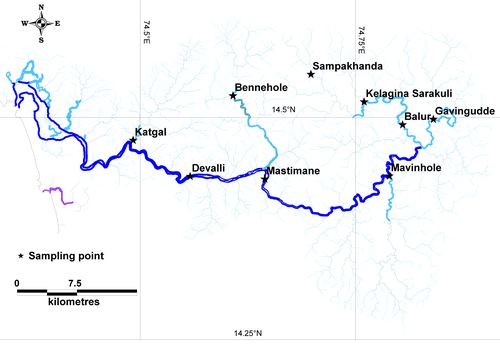 |
Diversity and Distribution of Aquatic Insects in Aghanashini River of Central Western Ghats, India |
 |
1Energy and Wetlands Research Group, Centre for Ecological Sciences [CES], Indian Institute of Science, Bangalore – 560012, India.
2Centre for Research in Aquatic Entomology, The Madura College, Madurai.
*Corresponding author: cestvr@ces.iisc.ac.in
|
MATERIALS AND METHODS
2.1 Study area: The Aghanashini or Tadri River (total length 121 km) originates in the Sirsi taluk of Uttara Kannada district in the Central Western Ghats of Karnataka State. It has two sources – the Bakurhole and Donihalla both situated in the Sirsi taluk. The streams join together forming the Aghanashini River; the latter winding its way through the valleys and gorges of Western Ghats taking a westerly course towards the South Indian west coast, joining the Arabian Sea in the Kumta taluk of Uttara Kannada (Figure 1). One more tributary Bennehole joins the river nearer to the coastal region. The Aghanashini has a catchment area of 2,146 sq. km, and an annual estimated discharge of 966 million cubic meters of water (Kamath, 1985 and Bhat, 2002).

Figure 1: Locations of sampling stations in the Aghanashini River
2.2 Sampling methods: The study was conducted during the post monsoon period of the year 2011. Nine sampling stations, viz. Gavingudde, Kelagina Sarkuli, Balur, Sampakhanda, Mavinhole, Bennehole, Mastimane, Devalli and Katgal, were selected in the Aghanashini River and its tributaries (Figure 1). Earlier studies elsewhere in Western Ghats have shown that aquatic insects are best studied during this period (Sivaramakrishanan et al., 2000). At each sampling locality, three important habitats - riffle, pool and edges were chosen for collection of aquatic insects. In each station, all these three habitats were sampled in three replicates. In the riffle area, insects were trapped in kick-net samples (1 x 1 m area, mesh size 500 µm); Insects were collected in pool habitat with “D” frame pond net. The edges, often overgrown with plants, or strewn with rocks etc. and difficult for application of any net method, were randomly surveyed using appropriate collection methods. The insects collected from all the three samples from each habitat type were pooled together and stored in 70% alcohol. The specimens were sorted, observed and identified up to the best possible taxonomic level using appropriate field keys (Dudgeon, 1999; Merritt and Cummins, 1988; Subramanian and Sivaramakrishnan, 2007; Balachandran et al., 2011). Functional feeding categorization of aquatic insects was made in accordance with Dudgeon (1999) and Merritt and Cummins (1988).
2.3 Data analysis: Species diversity indices such as Shannon-Weiner, Simpson’s, Evenness, and Margalef were computed to understand the biotic community of each study station. Shannon-Weiner diversity index helps in species relative abundance, Simpson’s diversity index points towards abundance of the most common species. Evenness index is used for the degree to which the abundances are equal among the species present in a sample or community. Margalef index is having a good discriminating ability and is sensitive to sample size; it is a measure of the number of species present for a given number of individuals. Cluster analysis of Ward’s method of distance was used to compare the distribution of aquatic insect community between the sampling stations.
|
|
Citation : Balachandran C., Dinakaran S., Subash Chandran M.D. and Ramachandra. T.V, 2012. Diversity and Distribution of Aquatic Insects in Aghanashini River of Central Western Ghats, India., Proceedings of the LAKE 2012: National Conference on Conservation and Management of Wetland Ecosystems, 06th - 09th November 2012, School of Environmental Sciences, Mahatma Gandhi University, Kottayam, Kerala, pp. 1-10.
|


